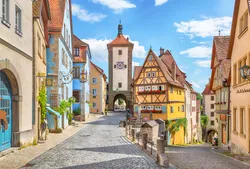See all articles relating to: Germany

The country known today as German is relatively modern. Before its unification in 1871, the region was made up of much smaller kingdoms, principalities, and duchies whose borders shifted frequently throughout history due to changing alliances and conflicts. A period of industrialization and economic growth in the 19th century was followed by the tumultuous years of the Weimar Republic and the rise of the Nazi Party in the 1930s. In the aftermath of World War II, the country was divided by the Iron Curtain, and later it was famously reunited with the fall of the Berlin Wall in 1989. Throughout its history, German has been shaped by numerous famous and influential figures, including Martin Luther, Johann Sebastian Bach, Immanuel Kant, Albert Einstein, Dietrich Bonhoeffer, Otto von Bismarck, and Angela Merkel.
Research your ancestors on MyHeritage
The states of GermanyThe states of Germany
Today, Germany is a federal republic composed of 16 states, known in German as "Bundesländer":
- Baden-Württemberg
- Bayern (Bavaria)
- Berlin
- Brandenburg
- Bremen
- Hamburg
- Hessen (Hesse)
- Mecklenburg-Vorpommern (Mecklenburg-West Pomerania)
- Niedersachsen (Lower Saxony)
- Nordrhein-Westfalen (North Rhine-Westphalia)
- Rheinland-Pfalz (Rhineland-Palatinate)
- Saarland
- Sachsen (Saxony)
- Sachsen-Anhalt (Saxony-Anhalt)
- Schleswig-Holstein
- Thüringen (Thuringia)
Former Eastern German Provinces and RegionsFormer Eastern German Provinces and Regions
- East Prussia (Ostpreußen) - largely today's Kaliningrad Oblast, Russia
- Memelland - largely in today's Lithuania
- Pomerania (Pommern) - part of today's Poland
- Posen - part of today's Poland
- Sudetenland - part of today's Czechia
- West Prussia (Westpreußen) - part of today's Poland
Other regions settled by Germans that did not become part of GermanyOther regions settled by Germans that did not become part of Germany
- Volga German ASSR in the Soviet Union
- Transylvania in Romania
German historyGerman history
Germany’s history is very complex, as the geographical region which has been deemed to constitute Germany has changed over time, often including parts of Austria, Poland, the Czech Republic and eastern France at different stages. Moreover, there have been a great many different states here across the centuries. For instance, during the late medieval and early modern period, there were times that there were over a thousand different polities here, some of them free towns and tiny principalities.
Long before there was a German state the broad geographical area was known as Germania and was inhabited by many Germanic, Celtic and other Indo-European tribes in antiquity. This was the region which the Romans began trying to conquer in the late first century BCE. It was the first region where Roman military might failed and after three Roman legions (approximately 15,000 men) were destroyed in the Battle of the Teutoburg Forest in 9 CE Emperor Caesar Augustus ordered the border to be pulled back to the River Rhine and an extensive series of forts and border defenses to be erected along the river's edge.[1] Thus, Germania would remain beyond the Roman frontier. It was from here that tribes like the Franks, Goths and Alans entered into the Western Roman Empire and overran it between the third and fifth centuries CE.
In medieval times Germany was conquered and incorporated into the empire of Charlemagne. Thereafter it was ruled by one branch of his descendants and later by other families which claimed the title of Holy Roman Emperor. Between the tenth and twelfth centuries the unified monarchy here disintegrated and Germany broke up into hundreds of different free cities, imperial cities, ecclesiastical states, dukedoms and counties ruled by feudal lords. The structure of the Holy Roman Empire created a sense of unity, but effectively there were hundreds of competing interests across the huge region.[2]
This situation pertained through the early modern period, with the Protestant Reformation of the sixteenth century creating fresh disunity, as some states adopted Lutheranism or Calvinism, while others remained ardently Roman Catholic.[3] Yet, eventually larger states such as Prussia, Bavaria, Baden, the Palatinate, Saxony and Hanover began to absorb the smaller powers, such that by the nineteenth century Germany was divided into less than fifty states. The largest of these, Prussia, finally managed to unite these into a German Empire in 1871 under the leadership of the Prussian statesman, Otto von Bismarck.[4]
Germany’s modern history has been one of extremes. Its desire to establish itself as the pre-eminent European power in the late nineteenth and early twentieth centuries led to a significant degree to the First World War (1914–1918) as Britain tried to stop the rise of Germany. While the manner in which Britain and France blamed and punished Germany for its role in fomenting the First World War was excessive, there can be no doubt that the Second World War (1939–1945) was brought about entirely by the German Nazis and their leader Adolf Hitler, a conflict which resulted in upwards of sixty million deaths, many of them owing to the genocidal policies of the Nazis. In the conflict’s aftermath Germany was divided yet again, this time into a pro-western West Germany and a Soviet-bloc East Germany, however, following reunification in 1990 Germany has emerged as a bastion of European stability and the pre-eminent economic force within the European Union.[5]
German geographyGerman geography
Germany is broadly divisible into five different geographical regions. In the north there are the German lowlands running along the coast of the North Sea and Baltic Sea and drained by the River Rhine in the west and others such as the River Elbe and River Oder in the east. Further to the south is a mountainous region in central Germany often referred to as the Mittelgebirge or ‘middle mountain range’. To the south and west of these are two plateaus dominated by heavily forested regions such as the Black Forest. Then Bavaria, which dominates the south of the country, is comprised of many foothills and lakes. Finally, in the extreme south of the country one reaches the German Alps, the highest region in Germany.[6]
The country’s human geography is complex as a result of the divided history of the region, with many regional capitals. Berlin is the capital in the north-east with some three and a half million people, but other cities like Hamburg, Munich and Cologne in the north, south and west respectively each have between one and two million inhabitants.[7] More people tend to live in the western parts of Germany, particularly along the course of the River Rhine, one of Europe’s great rivers and a region which has historically been rich in natural resources.[8]
See also:
Researching family history in GermanyResearching family history in Germany
A good starting point for tracing one’s ancestors in Germany is the German Federal Archives or Bundesarchiv. These are not located in Berlin as one might expect, but in Koblenz, as they were established when Germany was divided into West Germany and East Germany at the height of the Cold War, at which time locating an institution like this in Berlin was impractical. The Bundesarchiv contains records from a great many other repositories which have now been dissolved. For instance, it houses the records of the Deutsche Dienststelle, a German government agency which created extensive records pertaining to those who served in the German navy and military from 1871 onwards. It also holds the remaining records of the Stasi Records Agency, the secret police which controlled much of life in East Germany during the Cold War. Many of these records are reconstructed from hundreds of thousands of records which were shredded as Soviet control of East Germany collapsed at the end of the 1980s.[9]
Because of the fragmented history of Germany prior to unification in 1871, many records for the study of family history and genealogy are found in the different federal states which still constitute Germany today. For instance, people looking to trace an ancestor who lived in Prussia in the early nineteenth century would be best advised to start at the Prussian Privy State Archives or Secret State Archives in Berlin, which contains many records pertaining to Prussia between the sixteenth and nineteenth centuries.[10] Similarly, those investigating their family history in southern Germany might be best off starting their research at the Bavarian State Archives, which houses primary source material dating back to 777 CE during the reign of Charlemagne, for which time the first royal charter for the region is extant.[11]
German ethnicityGerman ethnicity
German has a diverse population that includes several ethnic groups. The majority of the population identifies as German, but there are also significant numbers of Turkish, Polish, and Russian citizens. Other minority groups in German include Italians, Greeks, and members of the Romani community. Additionally, German is home to many immigrants from around the world, including North and South America, Africa, and Asia. Despite occasional tensions between different ethnic groups, German is a country that values and celebrates its diverse cultural heritage, which contributes to its rich and dynamic society.
German surnamesGerman surnames

German surnames provide important clues in family history research, as they are derived from various sources and have distinct meanings that can help trace family origins. Familiarity with common German surnames and their origins is helpful in genealogical research despite inconsistencies in their use throughout history. For example, the surname "Müller" means "miller," and the surname "Schmidt" means "smith". Most German commoners acquired their surnames in the Middle Ages, sometime around the 1300s, and for most areas, those surnames were fixed from one generation to another, disturbed only by variations in phonetics. German surnames can be derived from occupations, geography, characteristics, or patronymics.
See alsoSee also
- German genealogy
- German immigration
- German emigration
- Archives in Germany
- Vital records in Germany
- Birth records in Germany
- Death records in Germany
- Marriage records in Germany
- Census records in Germany
- Civil registrations in Germany
- Church records in Germany
- Newspaper records in Germany
- German military records
- Borders, maps and gazetteers for German genealogists
- German surnames
- Austrian surnames
- German ethnicity
- North and Western European ethnicity
- Greek and South Italian ethnicity
- East European ethnicity
- Reunification of Germany
- Volga Germans
- German South West Africa
- German emigration to North America
- Germany directories index
- Germany obituaries
Explore more about GermanyExplore more about Germany
- German historical record collections on MyHeritage
- Most common ethnicities in Germany on MyHeritage DNA
- Researching German Ancestors on MyHeritage, article by James M. Beidler on the MyHeritage Knowledge Base
- All webinars on German research on Legacy Family Tree Webinars
References
- ↑ https://www.smithsonianmag.com/history/the-ambush-that-changed-history-72636736/
- ↑ https://www.worldhistory.org/Holy_Roman_Empire/
- ↑ https://www.history.com/topics/religion/reformation
- ↑ https://www.britannica.com/biography/Otto-von-Bismarck
- ↑ https://www.deutschland.de/en/topic/politics/germany-europe/turning-points-of-the-20th-century
- ↑ https://www.countryreports.org/country/Germany/geography.htm
- ↑ https://citymonitor.ai/guides/what-are-biggest-cities-germany
- ↑ https://www.britannica.com/place/Rhine-River
- ↑ https://www.bundesarchiv.de/EN/Navigation/Home/home.html
- ↑ https://www.preussischer-kulturbesitz.de/en/about-us/spk-institutions/prussian-secret-state-archives.html
- ↑ https://www.stmwk.bayern.de/art-and-culture/archives.html

